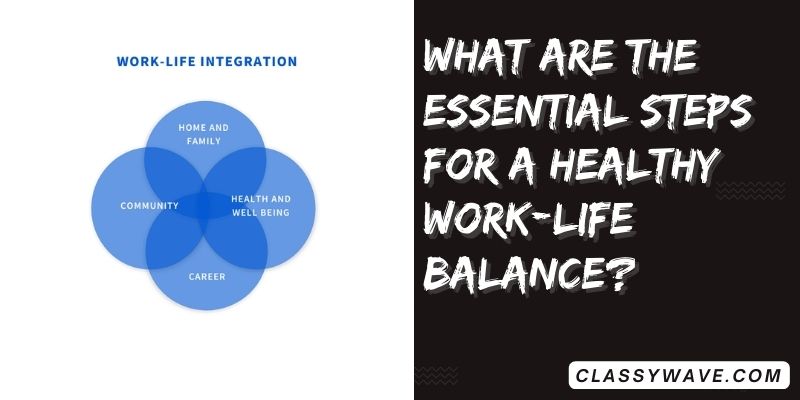What are the essential steps for healthy work-life balance?
Achieving a harmonious work-life balance is essential for overall well-being and sustained success. In this guide, we explore ten key strategies encapsulated in concise headings. From prioritizing wellness to smart delegation, these approaches offer actionable insights to help individuals navigate work and personal life demands, fostering a balanced and fulfilling lifestyle.
Prioritize Self-Care
Prioritizing self-care involves recognizing the importance of personal well-being. It encompasses activities and practices that nurture mental, emotional, and physical health. By dedicating time to activities that bring joy and relaxation, individuals can recharge and better cope with the demands of work and life, fostering a more resilient and balanced lifestyle.
Set Clear Boundaries
Setting clear boundaries is essential for maintaining a healthy work-life balance. It involves establishing limits between professional responsibilities and personal life commitments. By defining when work begins and ends, individuals can create a structure that prevents burnout, enhances focus during work hours, and allows for quality time with family and personal pursuits.
Effective Time Management
Effective time management is about optimizing productivity and relaxation. Techniques such as prioritizing tasks, creating schedules, and avoiding procrastination can help individuals make the most of their work hours. By allocating time strategically and efficiently, individuals can achieve professional goals while ensuring ample time for rest and recreation in their daily routines.
Establishing Healthy Routines
Establishing healthy routines involves creating consistent daily habits for both work and personal life. This includes regular sleep patterns, exercise routines, and dedicated time for meals. By incorporating positive habits into everyday life, individuals can enhance their overall well-being, improve focus, and create a balance that supports long-term physical and mental health.
Learn to Delegate
Learning to delegate is a crucial skill for achieving work-life balance. It entails identifying tasks that can be outsourced or shared with others, whether at work or home. Delegating effectively not only lightens individual workloads but also empowers others to contribute, fostering collaboration and reducing stress associated with trying to manage everything independently.
Technology Detox Strategies
Technology detox strategies involve managing screen time and digital distractions. This includes setting boundaries on device use, scheduling periodic breaks from screens, and cultivating mindful engagement with technology. By taking intentional breaks and limiting exposure to digital stimuli, individuals can reduce stress, improve focus, and promote healthier, more meaningful connections in both personal and professional spheres.
Foster Supportive Relationships
Fostering supportive relationships is crucial for a well-rounded life. Building a strong support system at work and home involves cultivating positive connections with colleagues, friends, and family. Supportive relationships provide emotional sustenance, encouragement during challenging times, and a sense of belonging, contributing significantly to overall well-being and the ability to navigate the complexities of work and personal life.
Continuous Learning and Adaptation
Continuous learning and adaptation are key elements for maintaining work-life balance. Embracing change and seeking personal and professional growth opportunities contribute to resilience and flexibility. By adopting a mindset of lifelong learning, individuals can stay agile in the face of challenges, enhance their skill sets, and adapt to evolving circumstances in their careers and personal lives.
Mindfulness and Stress Reduction
Incorporating mindfulness practices into daily life is essential for stress reduction and overall well-being. Mindfulness involves being fully present in the moment, cultivating awareness, and practicing techniques such as meditation or deep breathing. Integrating mindfulness into daily routines allows individuals to manage stress more effectively, improve mental clarity, and foster a greater sense of balance amid demanding work and personal responsibilities.
Regular Reflection and Evaluation
Regular reflection and evaluation involve periodically assessing one’s work-life balance. This includes reflecting on personal priorities, professional goals, and the effectiveness of current strategies for balance. Through self-evaluation, individuals can identify areas that need adjustment, set new priorities, and make informed decisions to ensure ongoing alignment with their values and aspirations, ultimately contributing to a more fulfilling and harmonious life.
Maintaining a wellness focus involves making deliberate choices to prioritize physical, mental, and emotional health. It encompasses activities such as exercise, proper nutrition, and adequate sleep. By consciously integrating wellness practices into daily life, individuals can enhance their resilience, energy levels, and stress management. A wellness-focused approach fosters a balanced lifestyle, ensuring that health is not sacrificed in pursuing professional success, and contributes to sustained well-being in both personal and work spheres.
Clear Work Limits
Setting clear work limits defines specific boundaries between professional and personal life. It involves establishing designated work hours and respecting them to prevent overwork and burnout. By communicating these limits effectively to colleagues and superiors, individuals create a structure that promotes a healthy work-life balance. Clear work limits facilitate focused and productive work during designated hours, allowing for dedicated time to relax, recharge, and engage in personal activities outside work responsibilities.
Time Optimization
Time optimization is strategically managing one’s schedule to maximize productivity and balance. This includes prioritizing tasks, minimizing procrastination, and creating efficient workflows. By implementing effective time management techniques, individuals can accomplish their professional responsibilities while leaving ample time for personal pursuits. Time optimization fosters a sense of control over one’s schedule, reducing stress associated with tight deadlines and creating space for relaxation and activities that contribute to overall well-being.
Healthy Daily Habits
Cultivating healthy daily habits involves establishing positive routines for physical and mental well-being. This includes regular exercise, proper nutrition, and consistent sleep patterns. By incorporating these habits into daily life, individuals promote overall health and resilience, enhancing their capacity to navigate the challenges of work and personal life. Healthy daily habits contribute to sustained energy levels, improved focus, and a greater ability to cope with stress, ultimately supporting a more balanced and fulfilling lifestyle.
Smart Delegation
Smart delegation is the strategic assignment of tasks to optimize productivity and reduce individual workload. It involves identifying tasks that can be delegated to others based on skills and resources. By charging intelligently, individuals not only alleviate their burdens but also foster collaboration and empower team members. Smart delegation allows for a more efficient distribution of responsibilities, preventing overwhelm and creating a workplace environment where everyone can contribute effectively to shared goals.
Conclusion
In conclusion, cultivating a healthy work-life balance is an ongoing journey that requires intentional choices and mindful practices. By incorporating the strategies outlined in this guide—prioritizing wellness, setting boundaries, optimizing time, embracing healthy habits, and practicing smart delegation—individuals can create a sustainable framework for success and well-being. Balancing professional and personal responsibilities enhances productivity and contributes to a fulfilling and rewarding life. The key lies in continuous self-awareness and a commitment to fostering equilibrium in all aspects of life.
FAQs
Question: How can I set clear boundaries between work and personal life?
Answer: Communicate your work hours, use designated workspaces, and resist the urge to check emails during personal time.
Question: What are practical strategies for time optimization in a busy schedule?
Answer: Prioritize tasks, minimize procrastination, and create efficient workflows to maximize your time.
Question: How do I foster supportive relationships at work and personal life?
Answer: Build connections, express appreciation, and actively listen to cultivate positive relationships in various aspects of your life.
Question: Can you provide tips for effective delegation without micromanaging?
Answer: Communicate expectations, trust your team’s capabilities, and provide necessary resources for successful task delegation.
Question: How can technology detox strategies be implemented for a healthier work-life balance?
Answer: Set designated tech-free periods, establish boundaries on device use, and prioritize face-to-face interactions to reduce digital distractions.







